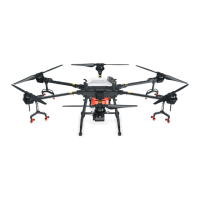©
2019 DJI All Rights Reserved.
27
AGRAS T16
User Manual
RTH Safety Notices
The aircraft cannot avoid obstacles during RTH if the operating environment is not
suitable for the radar module. Users can only control the speed and altitude of the
aircraft. Before each flight, it is important to set an RTH altitude that is appropriate for the
given environment. Go to Operation View in DJI MG2, tap , then , and Set Return
to Home Altitude.
5m
If the aircraft is flying under 5 m and RTH (including Smart and Failsafe RTH) is triggered,
the aircraft first automatically ascends to 5 m from the current altitude. You cannot control
the aircraft during this ascent. In Smart RTH, you can exit RTH to cancel automatic
ascent by pressing the RTH button once.
5m
H
The aircraft automatically descends and lands if RTH is triggered when the aircraft flies
within a 5 m radius of the Home Point.
The aircraft cannot return to the home point when the GNSS signal is weak (the GNSS
icon displays red) or is unavailable.
When the RTH altitude is set to more than 5 m and the aircraft is ascending between 5 m
and the preset RTH altitude, the aircraft stops ascending and immediately return to the
home point if the throttle stick is pushed.
Obstacle Avoidance During RTH
In an optimal operating environment, obstacle avoidance during RTH is available. If there is an obstacle
within 20 m of the aircraft, the aircraft decelerates and then stops and hovers. If the aircraft comes within
6 m of the obstacle while decelerating, the aircraft stops, flies backward to a distance of approximately 6
m from the obstacle, and hovers. The aircraft exits the RTH procedure and waits for further commands.
Landing Protection Function
Landing Protection activates during auto landing. The procedure is as follows:
1. After arriving at the home point, the aircraft descends to a position 3 m above the ground and hovers.
2. Control the pitch and roll sticks to adjust the aircraft position and make sure the ground is suitable for
landing.
3. Pull down the throttle stick or follow the onscreen instructions in the app to land the aircraft.
Low Battery and Low Voltage Warnings
The aircraft features a low battery warning, critical low battery warning, and critical low voltage warning.
1. Low Battery Warning: The aircraft status indicators slowly blink red. Fly the aircraft to a safe area and
land it as soon as possible, stop the motors, and replace the batteries.
2. Critical Battery Warning or Critical Voltage Warning (the battery voltage is lower than 47.6 V): the
aircraft status indicators rapidly blink red. The aircraft begins to descend and land automatically.
Users can set the threshold of low battery warnings.

